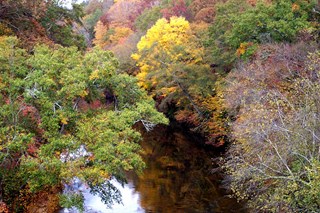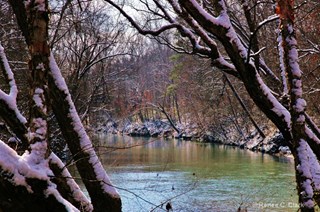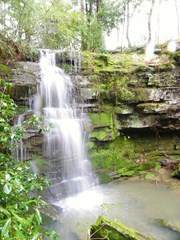


Buttahatchee River
* History: The Buttahatchee River is a tributary of the Tombigbee River, about 125 miles long, in northwestern Alabama and northeastern Mississippi in the United States. Via the Tombigbee River, it is part of the watershed of the Mobile River, which flows to the Gulf of Mexico.
The Buttahatchee River rises in northwestern Winston County, Alabama, near the town of Delmar, and flows generally westwardly through Marion County, where it collects a short tributary, the West Branch Buttahatchee River.
The river crisscrosses U.S. Highway 278 several times. At Hamilton, the river heads southwest and flows through the LaMarion Wildlife Management Area, and flows through Lamar County, Alabama and Monroe County, Mississippi; its lower reach is used to define part of the boundary between Monroe and Lowndes Counties. The Buttahatchee joins the Tombigbee near Columbus Air Force Base, 12 miles north-northwest of Columbus.
The name "Buttahatchee" is Choctaw for "sumac river", from bati, "sumac", and hahcha, "river."
Visitors can view caves along the river which were home to the Choctaw Indians and the Cherokee Indians. Relics and artifacts have been found along the river for many years. Just south of Hamilton, along the river, there are historic Indian mounds which are suited for visiting during your travels along the Buttahatchee.
** Recreation: Buttahatchee is a very nice Class I river, a great Class I and II float for rec boats and canoes. There are some good rapids, good fishing and beautiful cliffs. East of Hamilton on 278 there are two bridges that cross the Buttahatchee. The best section (with most rapids) is between these bridges. Its best level is from 500 to about 1500 cfs. A couple of rapids might be pushing Class 2 at high water. It has cliffs and a landscape very similar to Bear Creek (west). There are many houses visible from the river. The water quality is better than average here, and the fishing is great. Like most places around here, it’s better in the winter, and tough to catch at the right level in the summer. It is very rocky and you'll scrape all the way down at low water.
The first bridge outside Hamilton on 278 is the take out (with posted signs). The next bridge upstream on 278 is a newly built concrete bridge commonly known in the area as “burnout bridge" or the "new" bridge because a jet fuel tanker truck crashed on the bridge and burnt it up about 15 years ago. Between these two bridges are the best rapids. There are approximately four or five Class I rapids and many good shoals.
Going further east there is another bridge on 253 that will take you through historic Pearces Mill. There is an old mill dam that you have to portage around. Because of the dam, most of this section is flat water. There are a few small rapids as you approach the “new” bridge.
Many older folks float from Hamilton south to the old 78 or 43 bridges, but the old timers float it and fish it in flat bottom Jon boats, so I know that is flat too.
I will go down to 300 cfs. Between 300 and 500 cfs there is much scraping, and you have to pick your lines carefully to avoid the rocks. At 300 you are going to have to get out of the boat a couple of times, and at 500 you will not. The perfect level is 750 to 1000.
*** Fishing: Catfish, largemouth bass, crappie and bream are caught here.
Sources:
*Courtesy: Wikipedia
**Courtesy: Alabama White Water
***Courtesy: Anglerweb.com